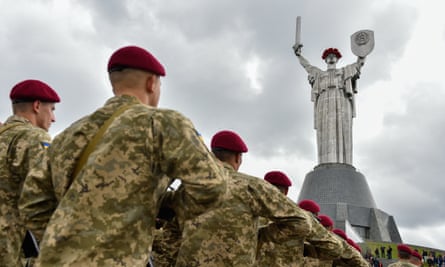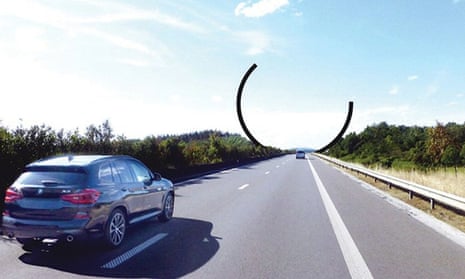A Belgian motorway has been confirmed as the site of what is being billed as the world’s tallest public artwork, which at 60 metres will be twice as high as the statue of Jesus in Rio de Janeiro and taller than the Statue of Liberty.
Arc Majeur, an imposing 250-tonne steel structure, will stand over the busy E411 between the city of Namur and Luxembourg, a spot chosen partly on the basis that a driver’s view will be unencumbered by any lampposts.
The sculpture is not expected to be formally inaugurated until October but the installation of its main sections will take place from the late evening of 10 August to 6am the following morning, it has been announced.
The French artist, Bernar Venet, who designed the arc told the Guardian that while there were taller monuments to historical figures, that as a purely artistic sculpture the Arc Majeur would be the tallest of its type on the face of the globe. “There is nothing like this anywhere in the world,” Venet said. “You will be able to see it 3km away.”
The €2.5m arc has had a troubled history including two failed attempts to install it in France.

It was initially due to be erected in 1984 near the city of Auxerre along the A6 leading to Paris, only to fall foul of a campaign from the local mayor despite the backing of the then French culture minister, Jack Lang. “It was for personal reasons,” Venet said of the mayor’s successful veto.
Subsequent plans for the artwork to hover over a road in Burgundy came to nothing after Venet rejected a proposal from officials from the president of French highway department to paint the Corten steel red. “I told him, ‘No way’, you can make your own,” Venet said.
It was only after collaborating with the Belgian mechanical engineering company, CMI, and its charitable foundation that the idea was given fresh impetus.
Venet said he had scoured the roads of Belgium for the right spot before alighting on a stretch of road near the village of Lavaux-Sainte-Anne on the outskirts of the city of Rochefort.
“There are lampposts everywhere in Belgium,” Venet said. “But here for 15 to 20 kilometres there are no poles. The driver will have plenty of time to discover it. What’s interesting about the sculpture is that people will not stop and look at it. It will be seen when people are in movement – and they will go through it and away.”
The sculpture will be formed of two arcs, of 28 metres and 60 metres in height, emerging from the earth on either side of the highway. About 1,000 tonnes of concrete will be used to keep it in place. “It had to be pure nature inserted with culture,” Venet added of his vision. The artist said that in time there may be two areas to the side of the motorway to allow people to view the structure.
Among Britain’s tallest freestanding artworks are the ArcelorMittal Orbit (114.5m) in Queen Elizabeth Olympic Park in London; the Aspire tower (60m) at the University of Nottingham’s Jubilee campus; and Antony Gormley’s Angel of the North (20m) in Gateshead.
The construction of the arc is largely being funded by the John Cockerill Foundation, a philanthropic arm of CMI based in Seraing, Belgium.
Venet has been described by Forbes magazine as one of France’s greatest living artists. “I had the idea in 1979 of two arcs on a road,” he said. “I thought it would be wonderful to do that. This is a dream for me.”
The artistic vision may be lost on some motorists this summer, however. Until mid-October, only one lane will be open for those coming to Belgium from Luxembourg and the road is to be completely closed to traffic on the evening of the sculpture’s installation.

Véronique Sorlet, a spokeswoman for the John Cockerill Foundation, said: “The assembly has several phases including welding the three elements of the great arc.
“Then we have to carry out the ad hoc checks and install the ‘dynamic damper’, which reduces the natural vibratory movement.
“Finally, a sanding operation will take place to standardise the [sculpture] at the same time as the earthworks to restore the site. We should have finished all this by the beginning of October.”
In 2016, Venet built a 20-metre-high arc at a roundabout in Bonn, Germany, entitled ARC ’89, to commemorate the fall of the Berlin Wall and Germany’s reunification. A temporary 22-metre-high arc by Venet was also installed near the Palace of Versailles in 2011 in the face of some criticism.
The Arc Majeur will still be dwarfed in Europe by the Motherland statue at the top of the Museum of the Great Patriotic War in Ukraine, at 102 metres high, and the Sanctuary of Christ the King in Almada, Portugal, which is 110 metres tall.
The tallest monument in the world, at 182 metres, is believed to be a statue of India’s first deputy prime minister, Sardar Vallabhbhai Patel in Gujarat.
